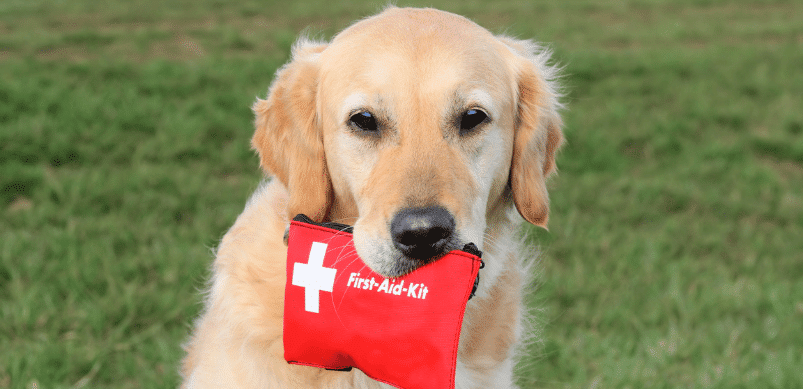First Aid for Pets: What to Do Before You Reach the Vet

When an emergency happens, every second matters — and knowing pet first aid can make a huge difference in your furry friend’s health and safety. Whether it’s a sudden injury, poisoning, or breathing issue, being prepared with the right first aid for dogs and cats can stabilize your pet until you reach a veterinary clinic.
Why First Aid for Pets is Important
Accidents and emergencies can happen at any time — from cuts and bites to choking or toxin exposure. While nothing replaces professional veterinary care, emergency pet care at home can:
- Prevent conditions from worsening
- Reduce pain and distress for your pet
- Buy you crucial time before reaching the vet

Step-by-Step Pet First Aid Actions
1. Stay Calm and Keep Your Pet Safe
- Approach slowly — frightened pets may bite or scratch.
- Muzzle your dog if needed (unless they’re vomiting).
- Move cats gently into a safe carrier.
2. Control Bleeding
- Apply gentle pressure with a clean cloth or bandage.
- Keep the area elevated if possible.
3. If Your Pet is Choking
- Look inside the mouth and carefully remove visible objects.
- For small dogs/cats, hold them upside down and pat the back.
- For large dogs, apply quick upward thrusts behind the ribcage.
4. Poisoning or Toxin Ingestion
- Do not induce vomiting unless directed by a vet.
- Rinse mouth with water if it’s a toxin like cane toad poison.
- Call your vet or an emergency poison helpline immediately.
5. Heatstroke Care
- Move pet to a cool, shaded area.
- Apply damp towels to body, especially paws and belly.
- Offer small amounts of cool (not ice-cold) water.
6. CPR for Pets (if not breathing)
- Lay pet on their side.
- Compress chest 100–120 times per minute.
- Give rescue breaths through nose every 2–3 compressions.
Pet First Aid Kit Essentials
Keep a kit at home and in your car. Must-haves include:
- Sterile gauze and bandages
- Scissors and tweezers
- Digital thermometer
- Saline solution
- Muzzle and gloves
- Vet/poison control emergency numbers
Recognizing Common Pet Emergencies
Pets can face a wide range of emergencies, from choking and poisoning to cuts, wounds, or fractures. Knowing how to recognize the signs of distress is the first step in emergency pet care. Look for symptoms like excessive bleeding, difficulty breathing, seizures, or sudden collapse—these require urgent veterinary attention.
Pet First Aid for Cuts and Bleeding
If your dog or cat gets a cut, apply gentle pressure with a clean cloth or sterile bandage to stop the bleeding. Avoid using harsh disinfectants like hydrogen peroxide unless directed by a vet. For severe bleeding, apply firm pressure and transport your pet to the vet immediately.
Choking and Breathing Problems in Pets
Choking is a life-threatening condition. Signs include pawing at the mouth, drooling, or difficulty breathing. Carefully open your pet’s mouth to check for visible objects. If you can safely remove it, do so gently with tweezers. If not, rush to the nearest vet while keeping your pet calm.
Heatstroke and Dehydration in Pets
Dogs and cats are highly vulnerable to heatstroke, especially during Australia’s hot summers. Symptoms include excessive panting, drooling, lethargy, or vomiting. Move your pet to a cool area, offer small amounts of water, and cool them with wet towels while seeking veterinary care.
First Aid for Poisoning in Dogs and Cats
Pets can ingest toxic substances such as chocolate, cleaning products, or plants. If poisoning is suspected, never induce vomiting without veterinary guidance. Flush your pet’s mouth with water if safe, and call your vet immediately for further instructions.
Why Every Pet Owner Needs a First Aid Kit
A pet first aid kit ensures you are always prepared for emergencies. Stock it with essentials like sterile gauze, adhesive tape, tweezers, antiseptic wipes, and a digital thermometer. Keep it handy at home and in the car for travel emergencies.
Frequently Asked Questions (FAQs)
1. What is pet first aid?
Pet first aid refers to the immediate care and basic treatment you provide to your dog or cat in case of an accident, injury, or sudden illness before reaching a veterinarian.
2. What should I do first if my pet is injured?
Stay calm, check for breathing and responsiveness, and provide basic emergency pet care such as stopping bleeding or keeping them warm until you reach the vet.
3. What items should be in a pet first aid kit?
A good pet first aid kit should include bandages, antiseptic wipes, tweezers, scissors, gloves, a digital thermometer, and your vet’s emergency contact information.
4. Can I give human medicine to my pet in an emergency?
No, never give human medicine to pets without a vet’s advice—it can be toxic. Always contact your veterinarian for proper treatment.
5. How do I learn more about first aid for dogs and cats?
You can consult your vet for advice, enroll in a pet first aid course, and keep trusted resources like AVW handy for ongoing pet care information.
Pro Tip: Keep your clinic stocked year-round with essential veterinary health supplies from Australian Vet Wholesalers.
For more professional resources, visit avw.com.au.
Tags
What do you think?
Related Articles

Top Dog Food for Hip & Joint Care: Best Nutrition for Active, Healthy Dogs
As dogs grow older—or if they’re large, athletic, or highly energetic—they’re more likely to face hip and joint challenges. Stiffness, arthritis, or reduced mobility can


Best Dog Food for Joint Health: Keep Your Pup Moving Happily
Just like us humans, dogs can experience joint problems as they age—or even earlier if they’re a large breed or very active. Whether it’s arthritis,
